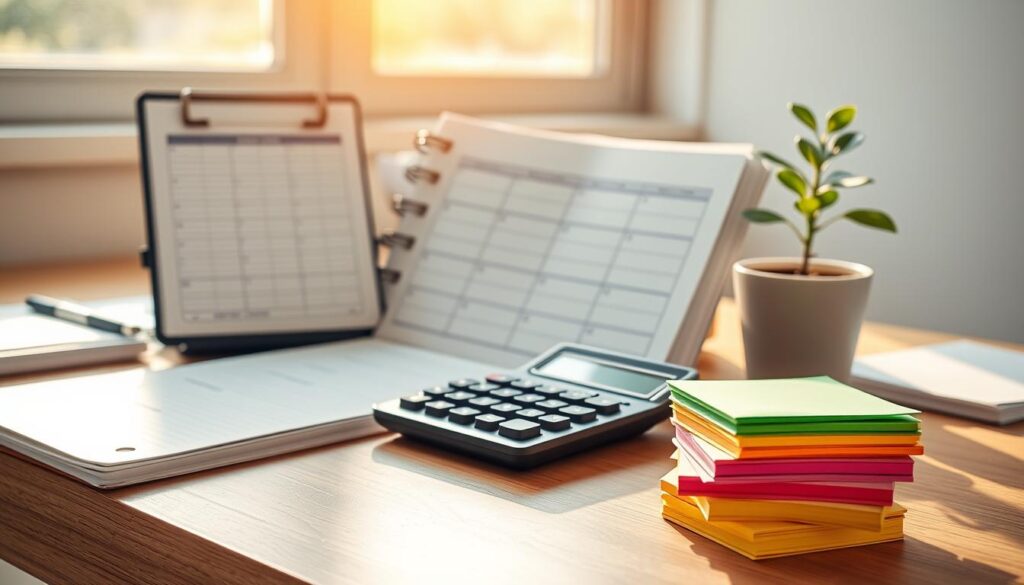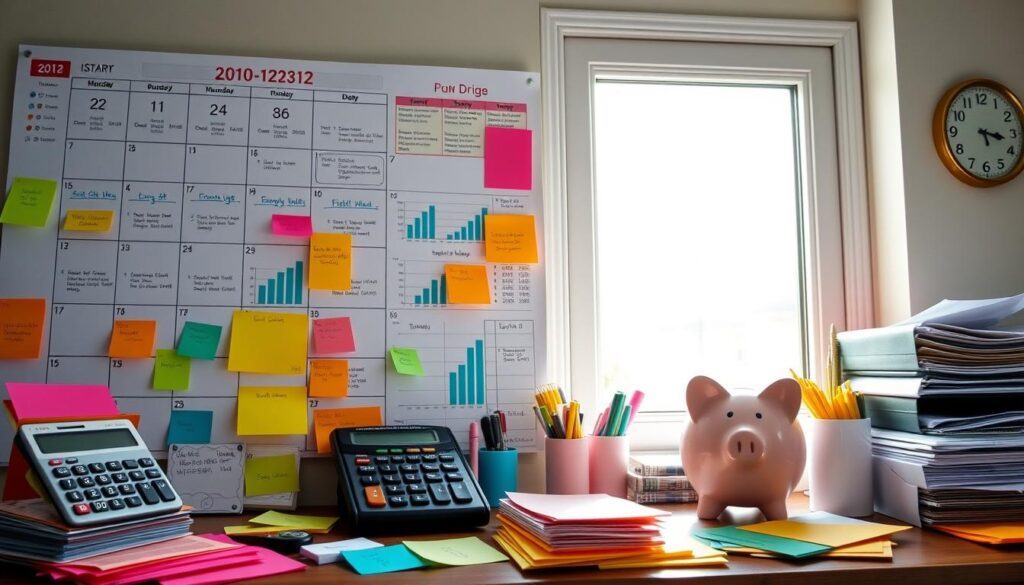As I look at the growing pile of bills, I feel overwhelmed. My debt has been a heavy burden for years, taking away my financial freedom. Today, I’m ready to take charge and start my #DebtFreeJourney towards a better future.
I’m not the only one struggling with debt. Millions of Americans feel trapped, unable to escape. But I want to show you that it’s possible to break free and #PayOffDebt. I’ll share the strategies and #FinancialTips that helped me become debt-free.
Key Takeaways
- Understand your current debt situation by assessing your total debt and categorizing your debts.
- Set clear financial goals, both short-term and long-term, to stay motivated and track your progress.
- Choose an effective debt repayment strategy, such as the Snowball or Avalanche method, to pay off your debts faster.
- Develop a budget that allocates extra funds towards debt repayment and cuts unnecessary expenses.
- Build an emergency fund to avoid relying on credit cards in unexpected situations.
Understanding Your Debt Situation
Before you can tackle your debt, you need to know how much you owe. This means looking at all your debts, sorting them, and making a detailed list. By doing this, you’ll understand your debt situation well. This knowledge will help you make a plan to pay off your debts.
Assessing Your Total Debt
First, collect all your financial papers. This includes credit card bills, loan statements, and any other debt-related documents. Then, add up the balances to see how much you owe in total.
Categorizing Your Debts
- High-interest debts (e.g., credit cards, personal loans)
- Low-interest debts (e.g., student loans, auto loans)
- Secured debts (e.g., mortgage, car loan)
- Unsecured debts (e.g., credit cards, medical bills)
Sorting your debts into these groups helps you know which to pay first. This is based on interest rates and the seriousness of not paying on time. Your financial breakthrough starts now. Take action here.
Creating a Debt Inventory
| Creditor | Debt Type | Balance | Interest Rate | Minimum Payment |
|---|---|---|---|---|
| Visa Card | Credit Card | $5,000 | 18% | $100 |
| Chase Bank | Personal Loan | $10,000 | 12% | $200 |
| Sallie Mae | Student Loan | $20,000 | 6% | $150 |
Having a detailed debt list helps you plan how to manage and eliminate your debts. It’s a key step in your journey to financial freedom.

Setting Clear Financial Goals
Setting clear financial goals is key to paying off debt. It helps you make a plan to become debt-free. We’ll look at short-term and long-term goals, the SMART goal framework, and how to track your progress.
Short-Term vs. Long-Term Goals
It’s important to have both short-term and long-term goals. Short-term goals, like paying off a debt in six months, give you quick wins. Long-term goals, like being debt-free in three years, help you see your big picture.
SMART Goal Framework
The SMART goal framework is crucial for effective goals. SMART means Specific, Measurable, Achievable, Relevant, and Time-bound. For example, a SMART goal could be: “Pay off my credit card with a balance of $5,000 in the next 12 months by allocating an additional $400 per month towards the debt.”
Tracking Your Progress
Keeping track of your progress is vital. Use a budgeting app, spreadsheet, or notebook to record your debt repayment. Celebrate your small wins to stay motivated. Regularly check and adjust your goals to stay on track.

Remember, setting financial goals is an ongoing process. It takes dedication and flexibility. By setting clear, measurable, and achievable goals, you’re on your way to becoming debt-free and reaching your financial dreams. The journey to wealth and freedom begins with a single step. Click here to start.
Choosing a Debt Repayment Strategy
Choosing the right debt repayment strategy is key to becoming debt-free. The Snowball and Avalanche methods are two popular choices. Let’s look at how they work and other options for your financial situation.
The Snowball Method Explained
The Snowball method starts with the smallest debt first. This builds momentum and confidence as you see progress. Once a debt is paid off, you use the money for the next smallest balance.
The Avalanche Method Explained
The Avalanche method focuses on high-interest debts first. It aims to save you money by targeting the most expensive debts. After paying off high-interest debts, you use the money for the remaining balances.
While the Snowball and Avalanche are well-known, other strategies exist. Consolidating debts into one loan can simplify payments. Debt management plans also offer help by negotiating with creditors.
The best strategy for you depends on your financial situation and goals. Take time to evaluate your options and choose what fits your needs.
Budgeting for Debt Repayment
Effective #BudgetingTips are key to paying off debt. A monthly budget helps control your money and pay off debts faster. Cutting unnecessary #SpendingHabits speeds up your path to being debt-free.
Creating a Monthly Budget
Start by tracking your income and expenses. List all your income sources, like salary, side hustles, or government help. Then, sort your expenses into fixed (like rent and car payments) and variable (such as groceries and entertainment).
Allocating Extra Funds for Debt
- Find extra money for debt, like bonuses or tax refunds.
- Pay off debts with high interest rates first, using the “avalanche” or “snowball” methods.
- Set up automatic debt payments to avoid late fees.
Cutting Unnecessary Expenses
Look at your budget to find ways to spend less. Cut back on dining out, entertainment, or unused subscriptions. Small savings can quickly add up and help with debt repayment.

“Budgeting is the key to financial success. It helps you prioritize your spending and ensures you have the resources to tackle your debts effectively.”
Building an Emergency Fund
Creating a solid emergency fund is key to becoming debt-free. It acts as a safety net for unexpected expenses or job loss. This way, you avoid high-interest debt and keep your finances stable.
Importance of an Emergency Fund
An emergency fund is like a safety net. It protects you from financial shocks. Without it, a sudden car repair or medical bill could set you back. Building this fund helps you stay on track to becoming debt-free.
How Much Should You Save?
Experts say to save three to six months’ worth of living expenses. This amount helps you cover unexpected costs without losing too much to savings. Start with saving $1,000, then increase it as you can.
Tips for Building a Fund Quickly
- Automate your savings by setting up regular transfers from your checking account to a dedicated emergency fund.
- Allocate any windfalls, such as tax refunds or work bonuses, directly to your emergency fund.
- Reduce discretionary spending and redirect those funds towards your emergency savings.
- Consider taking on a temporary side hustle or gig work to boost your savings contributions.
By focusing on #EmergencySavings and using these tips, you can build a strong emergency fund. This fund will give you peace of mind and support your financial goals.

Increasing Your Income
Boosting your income can speed up your #MoneyFreedom journey and improve your #CashFlowOptimization. Look into different ways to earn more money. This will help you pay off your debts faster.
Side Hustles and Gig Economy Options
The gig economy has many chances to make extra cash. You can do freelance work, online tasks, drive for rideshare, or deliver food. There are many side hustles to choose from, based on your skills, interests, and time.
Negotiating a Raise at Work
Consider asking for a raise at your main job. Research what others in your field make. Show your boss how you’ve helped the company and ask for a raise. Pick the best time to ask for it.
Selling Unused Items
Look around your house for things you don’t use anymore. You can sell electronics, furniture, clothes, and collectibles. There are many places to sell these items and make money for your debt.
| Side Hustle Idea | Potential Income | Flexibility |
|---|---|---|
| Freelance Writing | $15 – $100+ per hour | High |
| Rideshare Driving | $10 – $20+ per hour | High |
| Online Tutoring | $20 – $50+ per hour | Moderate |
| Reselling Goods | Varies depending on items | Moderate |
By trying these ways to make more money, you can move faster towards #MoneyFreedom and better #CashFlowOptimization. Having different ways to earn can help you pay off your debts quickly.

Staying Motivated on Your Journey
Staying motivated is key when you’re on a #DebtFreeJourney. It’s easy to lose steam, especially when the path ahead seems long. But, with the right mindset and strategies, you can stay motivated and celebrate your progress.
Visualize Debt-Free Living
Imagine what your life will be like when you’re debt-free. Picture the relief, financial freedom, and new opportunities. Whenever you feel discouraged, think back to this mental image. It will remind you of your goal and keep your motivation up.
Build a Support System
Surround yourself with people who get your #DebtFreeJourney. Join online communities, connect with friends or family who are also debt-free, or work with a financial coach. Having a support network can make a big difference in staying motivated.
Celebrate Small Wins
As you work towards your goal, celebrate every small victory. Whether it’s paying off a credit card, hitting a savings milestone, or negotiating a lower interest rate, take time to acknowledge your progress. These small wins will fuel your #MoneyMindset and keep you motivated.
“The secret of getting ahead is getting started. The secret of getting started is breaking your complex overwhelming tasks into small manageable tasks, and then starting on the first one.” – Mark Twain
Maintaining a Debt-Free Lifestyle
Getting out of debt is a big win, but keeping it that way is even harder. It’s important to spend wisely, check your finances often, and learn about money management. These steps help keep your #MoneyFreedom safe and your finances stable for the long run.
Smart Spending Habits
Spending wisely is crucial to stay debt-free. Don’t go back to old ways of spending. Instead, focus on what you really need, save, and invest wisely. Avoid buying things on impulse and choose cheaper options when you can. This way, you can stay on track financially and avoid getting into debt again.
Regular Financial Check-Ups
It’s important to regularly check your finances to stay debt-free. Take time each month to look at your money, spending, and savings. Make sure you’re meeting your financial goals. Keep an eye on your credit score and adjust your budget as needed. This helps you catch problems early and keeps your finances healthy.
Staying Educated on Financial Management
Learning about money is key to keeping your finances in check. Read good books on finance, go to workshops, or talk to financial advisors. Knowing the latest on budgeting, investing, and managing debt helps you make smart choices. This knowledge lets you adapt to financial changes and keep your finances strong.


